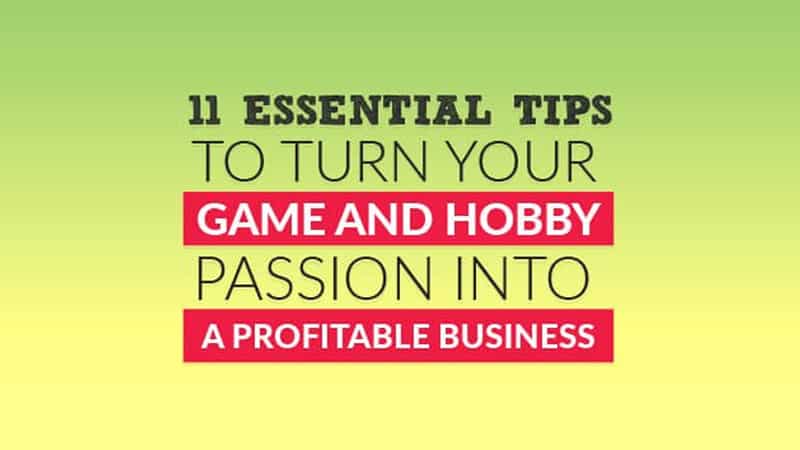So you have decided to want to take your passion for Games and Hobby from a pastime to a business? Congratulations! You are about to embark on a thrilling adventure sure to be fraught with many challenges, thrills, twists, and turns. The road from passion to profit can take many different directions. Some people work their way up from backpack trading. Other ambitious Game and Hobby fans grow their businesses and brands through content and events. Some already own game stores that are selling other kinds of games and decide to branch out into different categories.
Whichever path you choose, get ready for some hard work and a wild ride! Starting out as an entrepreneur can be overwhelming. To help you get started, we have put together this ebook with some tips, tricks, and fundamentals you need to know to help you be successful.
Good luck.
Get Your Head in the Game
While you have to have a great product, your attitude is going to be one of the biggest factors in the success of your Game and Hobby business. If you have identified your passion and have a can-do attitude, you are less likely to quit when the going gets tough. And believe me – the going will get tough!
Tip #1: Have the Right Mindset
Being a business owner won’t be easy. It’s going to involve long hours, difficult work, disappointments, failures, and criticism. Before starting on this path, you need to get real. Ask yourself: “Am I willing to work hard? Am I willing to do what it takes?” Business is full of risk and testing so you must have the courage to take a leap.
You also need to identify what your true passion is. What will you bring to this industry that nobody else can, and how will you communicate that to your customers? What will keep you going in the face of setbacks and challenges?
Lastly, remember: trolls are everywhere. If you think the stocky, tough, hard-to-kill-in-a-game variety was a challenge, be prepared to meet the online kind! The fact is that you will not be able to please everyone. People are going to criticize you and your business. Don’t lose your cool. Respond to them professionally and show them that humans organize your business, that you care, and that you are attentive to both positive and negative remarks. Understanding criticism is a gateway to understanding your customers, and it can be a valuable learning opportunity. Listen to their feedback; your passion and enthusiasm may be blocking you from seeing a potential obstacle. But don’t take it too personally – sometimes haters are just going to hate!
Players to the Starting Line!
You might have heard experts say “Business is the hard part!” While this is certainly true, there are many steps you can take before you start that will help you be successful. Just as you would study how a game is played before jumping in, you need to do some research and planning before embarking on your business journey.
Read on for some key ways to prepare!
Tips #2: Define Your Goals
Start with the end in mind. What do you hope to achieve? Just as you wouldn’t go on a journey without an endstate in mind, you don’t embark on the road to being an entrepreneur without first setting goals.
The most useful goals are SMART:
- Specific – Your goal is well-defined; it’s easy to see what you are trying to achieve.
- Measurable – You can clearly tell when you have achieved it and how much progress you have made.
- Attainable – Your goal is realistic.
- Relevant – Your goal brings value to your business; it relates to what you want to achieve.
- Timely – Your goal is time-based, not open ended.
Some good examples of SMART goals for starting a Game and Hobby business include:
- I will have my eCommerce site fully operational by May 1st.
- I will publish two new articles per week on my blog.
- I will acquire 5 new leads this month through my podcast.
- I will increase my Facebook followers by 100 in the next three months.
Having well-defined and clear goals will help you achieve your objectives and help your business grow.
Tip #3: Do Your Research
Before jumping into this field, you have to research, research, research! You are already an expert in your particular field, but now you need to know about your market.
Here are some things to consider:
- What are some characteristics of the market you are about to enter?
- Who is your competition? What services do they provide?
- Who is your ideal customer? Some things you should know about them include:
– typical age, gender, socioeconomic status, marital status, education level
– their goals and challenges
– what types of media they enjoy (blogs, podcasts, video, etc)
– what social networks they use most often
– what kinds of language and terms they use
The more you know about your market and your ideal customer, the more successful you will be at ensuring your product or business provides added value to the industry.
Tip #4: Make a Plan
Once you have done your research, you can start developing a business plan. Make it clear, to the point, and concise. This will keep you focused and help you continue to move forward even with obstacles in your way. Some of the important reasons to have a business plan are to ensure clear communication, aid in strategic planning, help streamline management, and to capture insights. Also, if you think you may need financial assistance, most banks will want to see a thorough and well-written plan. A solid business plan will continue to guide you through stages of growth as your business progresses.
A business plan typically includes:
- An executive summary
- A description of your business
- The products and services you will provide
- Sales and marketing strategy
- Operations (the administrative side of your business)
- Management team
- Development goals
- Financial summary
There are many great formats online to help you get started with your business plan.
Tip #5: Divide up Responsibilities
You may be starting out as a “solo-prenuer” in which case this step is easy: you are doing everything yourself! Just be aware – this is a challenging approach. It would benefit you to think about ways you could outsource tasks or where you might need to hire people that will work for you. Too many hobby-turned-to-business entrepreneurs try to do everything themselves and burn out. Some tasks that could be outsourced include inventory, billings, maintaining the physical and online store, marketing, selling, and more. Unless you are Superman and your only weakness is Kryptonite, then go ahead and DIY! However, for most people it makes more sense and is more productive to focus your energy on what you are good at instead of trying to do everything. DIY is good for the short term, but in the long run it will exhaust you, and your resources and your venture will eventually fail.
No matter how successful your business becomes, you cannot buy time. As you grow, consider ways to leverage your revenue to hire passionate people to work for you. Individuals who share the same devotion and zeal will be able to be trusted with your business as it grows.
Ready, Set….. GO!
Now that you have identified your passion, done your research, and gathered your team, you are ready to start your business! There’s just one thing left to consider: how do you attract customers?
The prevalence of the internet has fundamentally changed the way we do business. Almost everyone will perform some type of online research to answer a question or before they make a purchase. Physical advertising space is no longer a premium. Gone are the days of talking about the latest trends around the water cooler – now this is all done on social media.
What does this mean for you as a business owner? You need to focus on getting your brand found online. You need to optimize your website and create remarkable, educational, and engaging content that will bring customers to you.
Here’s an example: A customer is interested in learning to play a new game. His first step is to research that game online. He comes across a well-written and informative article on your blog about his very question. This blog post leads him to your website where he sees that he can subscribe to your email list or download an ebook for more information. This content might inform him that you sell a perfect starter pack for people interested in this game. Your content has convinced him this is the perfect solution to his problem of how to get started on this new hobby – and viola! You’ve got yourself a customer!
This is easier said than done however. You need to have a solid understanding of your ideal customer and what types of information he is going to be looking for and where. The goods news is that, if you are careful and diligent in this process, you can successfully connect with your customers without spending lots of mana… I mean, money!
Tip #6: Optimize Your Website
Your website is your home base. This is where strangers turn into visitors and where they will find your blog content, videos, podcasts, links to your social media pages, and more. However, since there are a million websites out there, how do you make sure customers find yours?
Your potential customers probably start their research into anything that interests them like most of us do – typing their question into a search engine. So, in order for customers to find your website, you need to make sure it is optimized to get found in that search.
Here are some things to think about when optimizing your website:
- Structure it around keywords your ideal customers will use – mimic their language
- Research the web for alternatives to that keyword
- Use longer, more specific keywords over short, general ones – big businesses are likely to have the market cornered on generic terms; you are more likely to get found if you focus on specifics
- Make sure your keywords are all over your page – titles, headers, body, metatags, and image alt-text
- If you have a physical business, get added to relevant online directories
- Make sure your site is viewable on mobile devices
These tips should help your website get found among the internet noise.
Tip #7: Your eCommerce Store
If you are selling a product, you are going to want an eCommerce site. The rapid growth of the eCommerce economy is continuing its upward trajectory. In just three years, total U.S. retail eCommerce sales increased from $167.3 billion to $263.3 billion. That is 9.5 percent of total U.S. sales! Crazy!
Now ask yourself, “Do I need a mobile site?” The answer is obvious – yes! Your eCommerce mobile site is your sales machine. A mobile-friendly site design can offer an exceptional shopping experience that will not confuse or overwhelm your customers.
There are many great services out there to use when building an eCommerce site. Do some research to find one that best meets your needs.
Tip #8: Blog, Blog, and Blog Some More!
Blogging is one of the marketing tactics that, when done well, has a huge return on investment. First and foremost, writing quality content that people want to read helps to establish you as an authority in your field. Blogging will also help drive traffic to your website and convert that traffic into leads.
Here are some best practices for successful blogging:
- Pick a topic that is relevant and useful to your ideal customer
- Each post should focus on only one main topic
- Format and optimize the post around well-researched keywords
- Use images, white space, bold text, and bulleted lists when appropriate to help key points stand out
- Include a call to action – or CTA – to continue to nurture visitors towards becoming customers
- Promote your blog posts on your website, social media channels, and other areas where your ideal customer will see it
- Analyze the results of your blog – there are many great tools to help with this!
Tip #9: Video Blogs and Podcasts
You are passionate about Game and Hobby and know a lot about the industry. Sharing your expertise through videos and podcasts allows your customers to really hear that passion in your voice. A well-made video or podcast where a potential customer can hear you speak with passion, confidence, and authority can go a long way towards increasing your brand influence and helping you be seen as an expert in your field.
Videos can also be a great way to encourage customers to purchase your products. Just a simple video of you unboxing a board game or a booster box can show your customers how awesome the product is and give them a chance to see it in action.
“How to” videos are also a great way to get found by customers.
After creating your video or podcast, make sure you leverage it by distributing it through different channels. Add links to it on your website and blog, and promote it on your social media sites. And don’t forget email: adding videos to your content such as email newsletters can boost email click through and open rates as much as 65%.
Tip #10: Be Social!
Facebook, Twitter, Instagram, Snapchat, and much more! These large social networks are taking over the online world. It is crucial to every business to have an active presence on social channels. However, you need to make sure you are using social media correctly. The wrong social media approach may hurt your brand, and eventually your followers may pull the plug on you!
Social media is helpful for many reasons. It increases your reach, helps promote your business, can drive leads to your website, and can be used to promote your blogs and other content. Use it wisely by providing educational data and valuable information that will keep your followers interested and engaged.
Use these tips to make the most of your social media presence:
- Have a strategy – make sure your posts are consistent with the message your brand is trying to send
- Publish constantly and consistently – use automation tools such as Hootsuite, Buffer, and Social Sprout to help schedule posts
- Focus on the channels where your ideal customer spends most of his time
- Analyze the results of your social media strategy and adjust as necessary
A big part of figuring out the best use of social media for your business is trial and error. Try posting different types of content at different times on different channels and analyze what works best.
Tip #11: Email
Email is another great way to nurture leads, promote your content, and continue to engage with previous customers. However, just like other forms of content, every email that you send to your Game and Hobby fans needs to be valuable.
Use email effectively by:
- Ensuring content is relevant to the recipient
- Using actionable language
- Personalizing your email for the recipient
- Taking steps to avoid having your email marked as spam
- Keeping your contact lists current
- A/B testing your emails to see what variations are most successful
- Analyzing the results of your email campaigns
- Optimizing your emails for viewing on a mobile device
- Including links to your website and social media channels
Final Words
When you turn your hobby into a full-time business, you will become your own boss and get the chance to make a living doing what you love. Take the time to get mentally prepared, do your research, and develop your brand. Provide a useful service that delights your visitors at every turn and your customers will turn into raving fans who will buy from you over and over again!



















